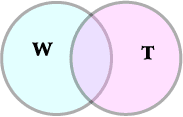|
The third version of the boy/girl
puzzle is the most tricky.
In the first two puzzles, we learn that a family has 2 children. We are
then given partial information about the children's genders:
Puzzle #1: The older
child is a girl.
Puzzle #2: At least one of the two is a girl.
The question then is, what is the
probability that the other child is a girl? As we learned on the first puzzle page, version 1 is simpler. In
version 1, we know everything about the older child and nothing about
the younger one. The gender of the younger child remains an independent
event. In version 2, we have a peculiar kind of knowledge. Some
observer—say the mother of the children—knows the genders of both, but
tells us only part of what she knows.
Now here is puzzle #3: You know
that a family has two children. One of the children walks into the
room, and it is a girl. What is the probability that the other child is
a girl?
— For a hint, please
scroll down —
Hint: Puzzle #3 is NOT
the same as puzzle #2.
— For the answer,
please keep scrolling —
Answer: 1/2
. That is, if one of the children walks in and she is a girl, the
probability is 1/2 that the other child is also a girl.
Explanation
We recall that, for puzzle #1 or
#2, there are 4 possible cases:
|
A
|
B
|
C
|
D
|
|
Older
|
girl
|
girl
|
boy
|
boy
|
|
Younger
|
girl
|
boy
|
girl
|
boy
|
Review Puzzle #1: If you are told
that the older child is a girl, then the
possibilities are only A and B. The probability of case A (2 girls) is
one out of two, or 1/2.
Review Puzzle #2. If you are told
that at least one child is a girl, this
excludes case D. The possibilities are A, B, and C, and only in case A
is the second child a girl. This is 1 case out of 3, so the probability
is 1/3.
In the case of puzzle #3, when "one
of the children walks in," there is an additional random
event by which one of the two children is chosen. Imagine that the
child walks in through a door. Outside the door, where we can't see it,
is a sign that says "Older child please walk in," or perhaps "Younger
child please walk in."
There are now 8 cases, but we can
use the same table above. The sign selects a row, chance selects a
column, and then we have an event such as "younger child walks in AND
it is a boy AND both children are boys."
So, if the sign says "older" and a
girl walks in, we must be in column A or column B, and the probability
of 2 girls (column A) is 1/2. If the sign says "younger," and a girl
walks in, by similar reasoning, column A or column C applies, and again
the probability of 2 girls (column A) is 1/2. If the probabilities of
"older" and "younger" are each 1/2, then the probability of 2 girls is
(1/2)*(1/2)+(1/2)*(1/2) = 1/2 .
To say it another way, there are 8
cases. In 4 of those cases, a girl walks in. But 2 of the 4 cases are
in column A. Therefore the chance of column A (both children are girls)
is 2/4 = 1/2.
This puzzle can also be treated as
an example in Bayesian Probability:
|
Bayesian
Probability
|
 |
Event W
is that a girl Walks into the
room. Event T is that the
family has Two girls. Reverend
Bayes then teaches that
P(T|W)P(W) = P(W|T)P(T) . Or,
P(T|W) = [P(W|T)P(T)]/P(W) .
Here by definition,
P(T|W) is the probability of T, given that W has occurred.
P(W) is the a priori probability of W.
Here P(W|T) is the probability of W, given that T has occurred.
P(T) is the a priori probability of T.
Well, P(W|T) is the probability
that a girl walks in, if there are 2 girls. P(W|T) = 1.
P(T) = a priori probability of 2 girls = 1/4 .
P(W) = a priori probability of a girl walking in = 1/2 .
Therefore P(T|W) = 1*(1/4)/(1/2) =
1/2 .
This is, of course, the same
answer as before. The Venn diagram above was a generic diagram to
stimulate thinking about Bayesian probability. Now that we have solved
the problem, we realize that T is a proper subset of W. That is, if the
family has Two girls, a girl will always Walk in. This diagram is still
not scaled according to probability but shows T as a proper subset of W:
Credit Where it is Due:
In an earlier version of these web pages, I had confused puzzle #2 and
puzzle #3, not realizing that they are different. Donald MacLeod questioned
what I had said, leading to this additional puzzle page. Thank you, Don.
<<Back
to boy-girl puzzles #1 and #2.
|